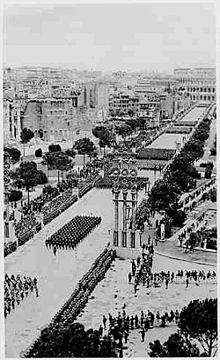Via dei Fori Imperiali

The street known today as Via dei Fori Imperiali ("Street of the Imperial Forums") was laid under Benito Mussolini as Via dell'Impero ("Street of the Empire") across the ancient excavation sites of the Imperial Forums as a parade street between Piazza Venezia and the Colosseum in Rome . It corresponds to Mussolini's basic concept, which he expressed on December 31, 1925 when the Roman governor Filippo Cremonesi was appointed : In 50 years Rome should be “great, orderly and powerful”, and the ancient monuments should, of all the ingredients of the “centuries of decadence” From this point of view (in the succession of Napoleon III and his colleague Georges-Eugène Haussmann ) between the Colosseum and the Piazza Venezia, where Mussolini gave his speeches, a visual and Road axis opened, although the hill of the Collina della Velia with the Renaissance garden of the Palazzo Rivaldi had to be cleared away. On October 28, 1932, Mussolini opened the new street on the occasion of the tenth anniversary of the March on Rome .
This road connection, which was already provided for in the Roman regulatory plans of 1873 and 1883, appears less conspicuous in a level location than in the plans of the 20th century, as it provided for a viaduct. On the other hand, during the construction (1924–32), in addition to numerous residential buildings, valuable ancient relics were simply destroyed - for example the base of Nero's colossal statue and the Meta Sudans , the remainder of an ancient fountain. In the early 1980s, left-wing city administrations in Rome tried to block or even dismantle the former Via dell'Impero, known as the parade route of the fascist battalions. In the 1990s, the imperial forums filled in for Mussolini's road construction were dug up again and the road narrowed. During this work, the green spaces between the street and the Imperial Forums were considerably reduced. The construction of the Linea C of the Metropolitana will lead to a redesign , which will already make some barriers, break-ins and work underground necessary.
On the initiative of Mayor Ignazio Marino , Via dei Fori Imperiali was closed to private traffic from August 3, 2013 between Largo Corrado Ricci and the Colosseum. The road remains open to public transport and taxis on weekdays. Marino declared it his goal to completely convert the street into a pedestrian zone within five years.
literature
- Antonio Cederna : Mussolini urbanista. Lo sventramento di Roma negli anni del consenso. Corte del Fontego, Venezia 2006, ISBN 88-951240-1-4 .
- Robert Schediwy : City Pictures. Reflections on the change in architecture and urbanism. 2nd Edition. Lit, Vienna 2005, ISBN 3-8258-7755-8 , especially p 204 ff.
Web links
- Paul Kreiner: The boulevard in Rome becomes car-free, His Majesty the pickaxe. Der Tagesspiegel , August 2, 2013, accessed on August 4, 2013 .
Individual evidence
- ↑ The name was changed in 1945. Compare Claudio Rendina, Donatella Paradisi: Le strade di Roma (= Biblioteca de Il Messaggero. Vol. 11). Volume 2: E-O. Newton & Compton, Rome 2004, p. 545. ISBN 88-541-0209-1 .
- ^ Austrian National Library: ANNO, Neue Freie Presse, 1932-10-29, page 2. In: anno.onb.ac.at. Retrieved July 13, 2016 .
- ↑ As of 2016
- ↑ Cecilia Gentile: Marino: “Entro 5 anni pedonale tutta via dei Fori. Non ci fermeremo ”. La Repubblica , August 2, 2013, accessed August 2, 2013 .


